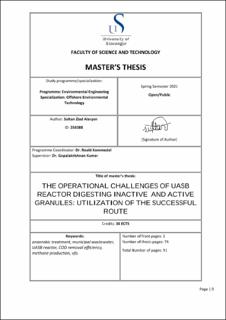| dc.description.abstract | This study aims to investigate the challenges coupled with an anaerobic treatment of municipal wastewater using UASB reactor to convert organics into biogas. A laboratory scaled reactor is set up to treat synthetic wastewater with COD below 1200 mg/l under psychrophilic conditions. Reactor I is carried with inactive granules, while Reactor II is carried with fresh active ones. Hydraulic retention time (HRT) applied was 84 hours 31-17 hours for Reactors I and II, respectively.
The idea of running two experiments under the same conditions is to investigate the COD removal efficiency differences and methane production between both reactors. The removal efficiencies were very low in Reactor I (around 20%), while the accumulation of VFAs was very high as expected. In Reactor II, the removal efficiency reached 84% of the inlet COD, the desired value. The optimum biogas production was hard to determine due to a mechanical failure in the gas detector, but the bubbles flowing up from the inlet to the top of the Reactor were obvious. Nutrient removal was another drawback for both reactors where the values in the effluent were high. Some challenges led to having those values while running the Reactor, which are appropriately discussed in the discussion section.
For Reactor I, it was impossible to save the performance of the inactivated granules for optimizing a stable reactor with constant pressure and pH. We proposed to transform the aim of running a reactor of similar conditions to utilize VFAs production instead of biogas production. The VFAs have a significant market value and could be beneficial economically and environmentally.
A suggestion of pre-treatment and post-treatment techniques is also presented for Reactor II in order to have the optimal removal efficiency, and to stay within the margins before disposing the effluent. | |
